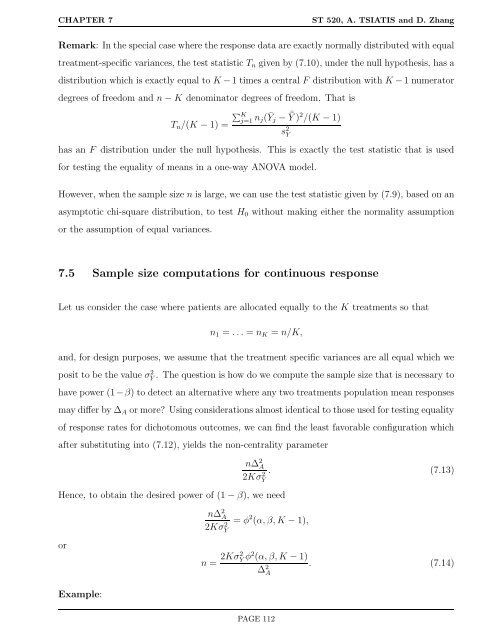ST 520 Statistical Principles of Clinical Trials - NCSU Statistics ...
ST 520 Statistical Principles of Clinical Trials - NCSU Statistics ...
ST 520 Statistical Principles of Clinical Trials - NCSU Statistics ...
Create successful ePaper yourself
Turn your PDF publications into a flip-book with our unique Google optimized e-Paper software.
CHAPTER 7 <strong>ST</strong> <strong>520</strong>, A. TSIATIS and D. Zhang<br />
Remark: In the special case where the response data are exactly normally distributed with equal<br />
treatment-specific variances, the test statistic Tn given by (7.10), under the null hypothesis, has a<br />
distribution which is exactly equal to K −1 times a central F distribution with K −1 numerator<br />
degrees <strong>of</strong> freedom and n − K denominator degrees <strong>of</strong> freedom. That is<br />
Tn/(K − 1) =<br />
� Kj=1 nj( ¯ Yj − ¯ Y ) 2 /(K − 1)<br />
has an F distribution under the null hypothesis. This is exactly the test statistic that is used<br />
for testing the equality <strong>of</strong> means in a one-way ANOVA model.<br />
However, when the sample size n is large, we can use the test statistic given by (7.9), based on an<br />
asymptotic chi-square distribution, to test H0 without making either the normality assumption<br />
or the assumption <strong>of</strong> equal variances.<br />
7.5 Sample size computations for continuous response<br />
Let us consider the case where patients are allocated equally to the K treatments so that<br />
s 2 Y<br />
n1 = . . . = nK = n/K,<br />
and, for design purposes, we assume that the treatment specific variances are all equal which we<br />
posit to be the value σ2 Y . The question is how do we compute the sample size that is necessary to<br />
have power (1−β) to detect an alternative where any two treatments population mean responses<br />
may differ by ∆A or more? Using considerations almost identical to those used for testing equality<br />
<strong>of</strong> response rates for dichotomous outcomes, we can find the least favorable configuration which<br />
after substituting into (7.12), yields the non-centrality parameter<br />
n∆2 A<br />
2Kσ2 Y<br />
Hence, to obtain the desired power <strong>of</strong> (1 − β), we need<br />
or<br />
Example:<br />
n∆2 A<br />
2Kσ2 Y<br />
. (7.13)<br />
= φ 2 (α, β, K − 1),<br />
n = 2Kσ2 Y φ2 (α, β, K − 1)<br />
∆2 . (7.14)<br />
A<br />
PAGE 112
















